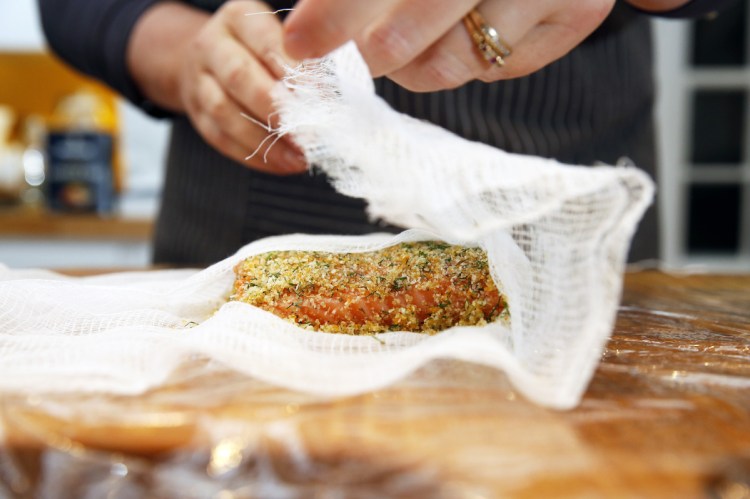DIY gravlax – salmon cured according to Scandinavian tradition – is a delicacy that embodies sustainable eating from all sides of the equation. The ingredients can be sustainably sourced, very little energy from fossil fuel is required to prepare it, which is a simple process in and of itself, and the end result is so luxuriously flavorful that a small portion easily satisfies even if it ’tis the season known for overconsumption.
Gravlax differs from traditional Jewish lox in that the latter requires the fillet to be taken from the salmon’s belly and cured in a strictly salty brine. For gravlax, any part of the salmon fillet is cured in salt, sugar, white or black pepper and tons of dill with optional additions of juniper berries, citrus, horseradish and vodka or aquavit. Smoked salmon is also cured in a salty flavored brine but then it is smoked at various temperatures depending whether you desire a smooth, silky texture or a firm, flaky one. (Today, lox often is another word for Nova smoked salmon.)

The author sprinkles a citrus rub on a filet of salmon to make gravlax.
While the traditional flavors of gravlax have endured the test of time, modern refrigeration means the prospect of making gravlax for New Year’s Day brunch does not involve taking out your garden spade as was required in medieval times when the Scandinavians had to deal with huge catches of spring and summer salmon pulled from the fjords. Gravad lax, which literally means “buried salmon” and has since been shortened to gravlax, was originally made by digging a hole in the ground, putting in layers of salmon and salt and covering the hole. Since salt was scarce at that time, the fish was left for long periods of time so that a second fermentation process made the fish safe to eat. But this pickling also made the fish very pungent so sugar, pepper and pine needles were added to soften the sourness. Eventually, the pine needles were replaced by easy-to-grow, and powerfully scented dill.

Christine Burns Rudalevige drizzles vodka on a salmon filet to make gravlax.
“Over time, the recipe for gravid lax has been adapted – for pleasure and profit, as it were, rather than survival,” Hugh Fearnley-Whittingstall and Nick Fisher wrote in “The River Cottage Fishbook: The Definitive Guide to Sourcing and Cooking Sustainable Fish and Shellfish.” Applying the same flavorings to thick pieces of sustainably sourced salmon – from either well-managed wild fisheries in the Pacific Northwest or Alaska or responsibly farmed salmon operations that have earned a nod from organizations like Monterey Bay Aquarium’s Seafood Watch or the Global Aquaculture Alliance’s Best Aquaculture Practices program – for a matter of days instead of months yields a lightly cured, but highly aromatic, flavorful end product. This same process works well with other fatty fish like mackerel, bluefish and even sea bass. Making a big batch of the stuff, you can extend the shelf life of fish from a couple of days to a couple of weeks. And because gravlax freezes well, those weeks can turn into months, thereby cutting down on any potential food waste.
I made some gravlax to start 2019 off on the right green-eating footing. Trust me, it was no sacrifice.
CHRISTINE BURNS RUDALEVIGE is a food writer, recipe developer and tester and cooking teacher in Brunswick, and the author of “Green Plate Special,” a cookbook from Islandport based on these columns. She can be contacted at cburns1227@gmail.com.

Christine Burns Rudalevige adds lemon zest to a mixing bowl before rubbing a salt-sugar cure onto a salmon filet.
This recipe can easily be doubled or tripled to make a big batch, but I suggest you try it first on a single center-cut piece of salmon to gain an understanding of the process. The center cut is typically more uniform in thickness, which allows it to cure evenly. Sliced very thinly on a bias, this cured salmon is delicious on a bagel with cream cheese and slivered onions; makes a complementary topping for an orange, fennel and dill salad; can be a fine replacement for Canadian ham on Eggs Benedict; and sits just fine on its own atop a slice of pumpernickel bread as a snack.
3 tablespoons kosher salt
3 tablespoons sugar
½ teaspoon crushed black pepper
½ cup chopped fresh dill
Zest of 1 lemon and 1 orange
1-pound, skin-on piece of salmon fillet
2 tablespoons vodka
Place a piece of plastic wrap (large enough to wrap around the entire fish) on a clean work surface. Place a double layer of cheesecloth, twice the size of the salmon, on top of the plastic wrap.
Combine salt, sugar, pepper, dill and zest in a small bowl.
Sprinkle 2 tablespoons of the dry cure mixture onto the cheesecloth, roughly in the shape of the piece of salmon. Place the salmon, skin side down, on top of the dry cure. Drizzle vodka over the fish. Evenly spread the remaining dry cure over the salmon and use your hands to rub it into the fish. Wrap the cheesecloth around the salmon, followed by the plastic wrap, and form a tight package.
Place the wrapped salmon on a wire rack set in a sheet pan or in a baking dish. Top the salmon with a weight (I use a large can of tomatoes). This presses the fish into an even thickness, which expedites the curing process.
Refrigerate for at least 24 hours but not more than 3 days, turning it every 12 hours. Less curing time yields a softer cured fish, both in terms of flavor and texture.
Remove salmon from wrapping and rinse the salt off with cool water. Place the salmon back on the wire rack and place in the refrigerator (uncovered) for about an hour to air dry. Wrap tightly until ready to serve.
To serve, slice gravlax very thinly on a bias.
Send questions/comments to the editors.


